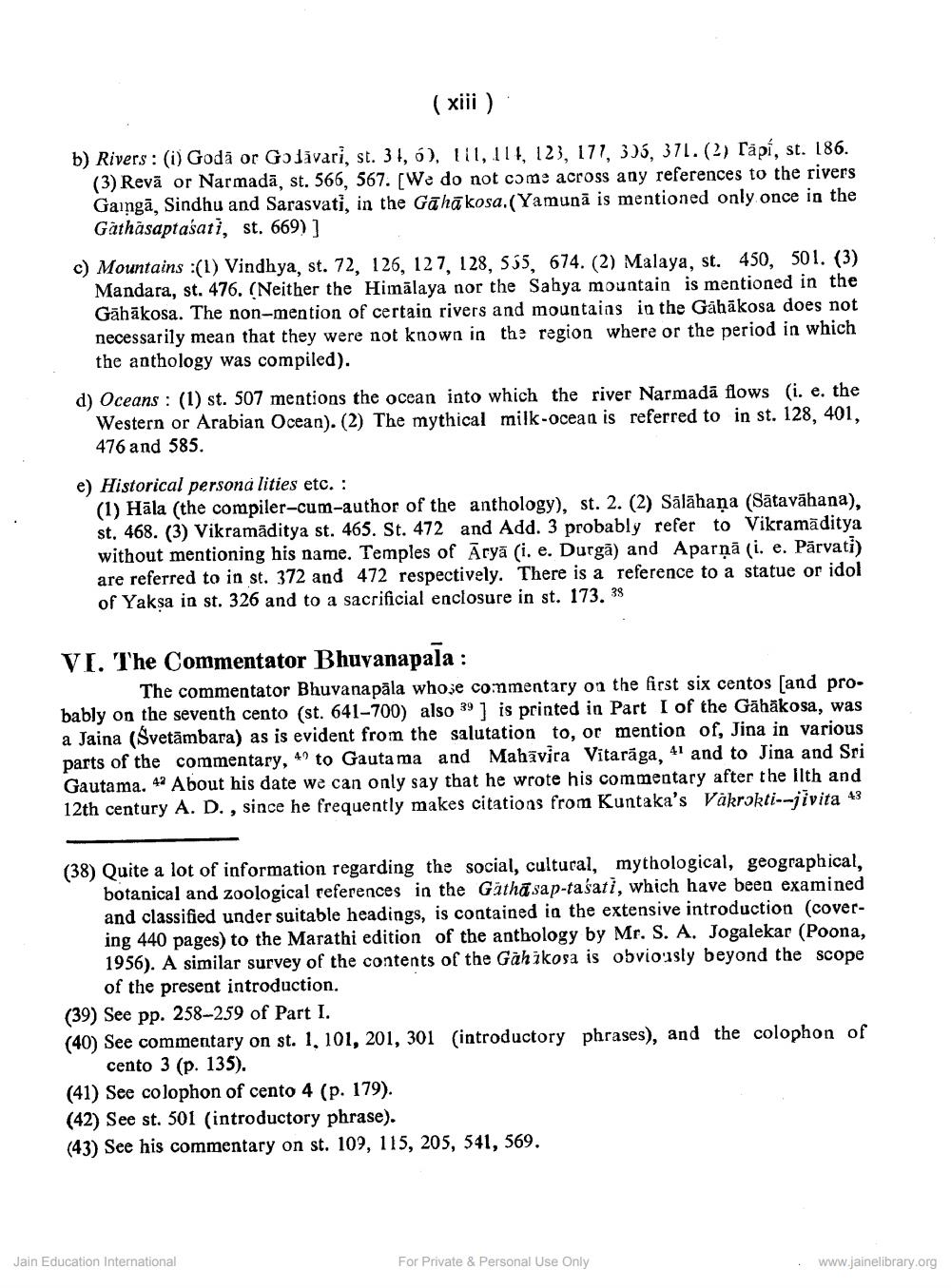________________
(xiii)
b) Rivers : (i) Godā or Gylivari, st. 31, 6), 111, 114, 123, 171, 375, 371. (2) Capí, st. 186.
(3) Revā or Narmadā, st. 566, 567. [We do not come across any references to the rivers Gaingā, Sindhu and Sarasvati, in the Gāhā kosa.(Yamunā is mentioned only once in the Gathāsaptašati, st. 669) ] c) Mountains :(1) Vindhya, st. 72, 126, 127, 128, 555, 674. (2) Malaya, st. 450, 501. (3) Mandara, st. 476. (Neither the Himālaya nor the Sahya mountain is mentioned in the Gähākosa. The non-mention of certain rivers and mountains in the Gabākosa does not necessarily mean that they were not known in the region where or the period in which
the anthology was compiled). d) Oceans : (1) st. 507 mentions the ocean into which the river Narmadā flows (i. e. the Western or Arabian Ocean). (2) The mythical milk-ocean is referred to in st. 128, 401, 476 and 585.
e) Historical persona lities etc. :
(1) Hāla (the compiler-cum-author of the anthology), st. 2. (2) Sālāhaņa (Sātavāhana), st. 468. (3) Vikramaditya st. 465. St. 472 and Add. 3 probably refer to Vikramaditya without mentioning his name. Temples of Aryā (i. e. Durgā) and Aparņā (i. e. Pārvati) are referred to in st. 372 and 472 respectively. There is a reference to a statue or idol of Yaksa in st. 326 and to a sacrificial enclosure in st. 173. 38
VI. The Commentator Bhuvanapala :
The commentator Bhuvana pāla whoje commentary on the first six centos [and probably on the seventh cento (st. 641-700) also 39 ] is printed in Part I of the Gāhākosa, was a Jaina (Svetāmbara) as is evident from the salutation to, or mention of, Jina in various parts of the commentary, 49 to Gautama and Mahavira Vitarága, 41 and to Jina and Sri Gautama. 4a About his date we can only say that he wrote his commentary after the Ilth and 12th century A. D. , since he frequently makes citations from Kuntaka's Väkrökti--jivita 43
(38) Quite a lot of information regarding the social, cultural, mythological, geographical,
botanical and zoological references in the Gathā sap-taśati, which have been examined and classified under suitable headings, is contained in the extensive introduction (covering 440 pages) to the Marathi edition of the anthology by Mr. S. A. Jogalekar (Poona, 1956). A similar survey of the contents of the Gahikosa is obviously beyond the scope
of the present introduction. (39) See pp. 258-259 of Part I. (40) See commentary on st. 1, 101, 201, 301 introductory phrases), and the colophon of
cento 3 (p. 135). (41) See colophon of cento 4 (p. 179). (42) See st. 501 (introductory phrase). (43) See his commentary on st. 109, 115, 205, 541, 569.
Jain Education International
For Private & Personal Use Only
www.jainelibrary.org




